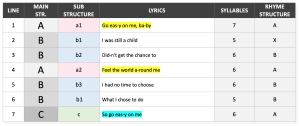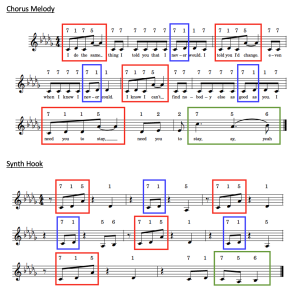Columbia Records reached a new milestone in 2021 with a whopping 33 weeks at #1, the most in the label’s history and third most for any label in Hot 100 history.
The label owes this achievement to nine songs: BTS’s Butter (10 weeks at #1) and Permission To Dance (1 week), Justin Bieber and The Kid LAROI’s Stay (7 weeks), Adele’s Easy On Me (7 weeks), 24kGoldn and iann dior’s Mood (2 weeks), Polo G’s Rapstar (2 weeks), Mariah Carey’s All I Want For Christmas Is You (2 weeks), and Lil Nas X’s Montero (Call Me By Your Name) (1 week) and Industry Baby (1 week).
To pay homage to Columbia’s success, we’ve compiled a treasure trove of songwriting techniques and full-length reports detailing the what, how and why behind these songs’ success, all of which are geared towards helping you better your own craft and musicality.
Easy On Me‘s Chorus Hook Structure Technique
Adele’s smash #1 hit Easy On Me, which marked the singer’s triumphant return to music after a five-year hiatus, owes much of its success to its beautifully written and strategically structured chorus.
The section possesses an ABBABBC main melodic part structure (shown in greyscale), which is both easy-to-follow and possesses an effective balance of repetition and contrast. The melodic sub-parts (shown in color) mirror this but feature slight melodic variations (e.g. a1, a2, etc.), which helps to keep things interesting without sacrificing connection value or memorability.
Of all the melodies in the section, it’s the A’s that are most important, as they house Easy On Me’s song-defining hook. The hook itself achieves a few key things:
- Its placement at the very beginning of the chorus helps to bolster memorability and the chorus’s impact.
- It contains the song title and provides the narrative’s main lyrical payoff.
- It showcases Adele’s famously stellar vocal chops, which was a well-warranted choice to powerfully welcome her back to the stage following her hiatus. This also satisfies Adele’s audience’s expectations, as this is the style of singing they have grown accustom to hearing from her.
- Its descending melody provides balance against the ascending melody at the end of the verse that directly precedes it.
The hook melody is then repeated once more on line 4, where it is paired with a new lyric to keep things interesting and further the narrative. Despite the lyrical change, note that the lyric “feel” in line 4 rhymes with “easy” from line 1 and uses the same “ee” syllable on the downward run to help keep the two hook repetitions cohesive.
Between the two iterations of the high, vibrant hook are two part B melodies, which are far less adventurous, sit in a lower range and are significantly less vibrant. This was a strategic choice that both helped the part A hook to further stand out in comparison and make the section as a whole easier to sing along with.
Lastly, the single part C melody at the end of the section features a melodically varied version of the song title hook. While somewhat reminiscent of the part A’s – particularly in the downward run on the lyric “easy” and its conclusion on the third scale degree – this less vibrant iteration provides engaging contrast while reinforcing the song title one last time as the section comes to a close.
In addition to their catchiness, both variations of the hook also achieve strong prosody with the accompaniment to heighten the listener’s emotional connection with the song. The vibrant and soaring vocal of the part A versions strongly emphasizes Adele’s desire for her partner to go easy on her, while the part C version is more subdued to show her fragility during the situation and provide more emotional depth.
Stay‘s Chorus and Hook Foreshadowing Technique
As is the case with many of today’s most successful hits, The Kid LAROI and Justin Bieber’s chart-topper Stay expertly uses hook foreshadowing techniques to make the song even more memorable, cohesive and catchy. Here, the astute listener will notice that the synth hook, which is featured front-and-center in the intro and subsequently reinforced throughout the majority of the song, also foreshadows and reinforces the chorus melody in fresh but familiar ways.
While the chorus melody is not a verbatim repetition of the synth hook, it does utilize key portions of the hook’s melody to heighten its familiarity and memorability, as shown in the sheet music below.
Subscribers can also view the following 100+ page song reports and techniques for the rest of Columbia’s songs, as well as our entire library of reports and techniques!
100+ Page Hit Song Deconstructed Reports
Read Butter‘s song report >>>
Read Industry Baby‘s song report >>>
Read Montero (Call Me By Your Name)‘s song report >>>
In-Depth Techniques
Dive even deeper into chorus foreshadowing with Permission to Dance >>>
Understand Mood‘s methodical genre and influence blend >>>
See how Rapstar utilized S.I.A.s to maintain interest throughout the song >>>
Not a Subscriber? Click here to learn more about the Hit Songs Deconstructed platform, or click here to view our subscription options!


